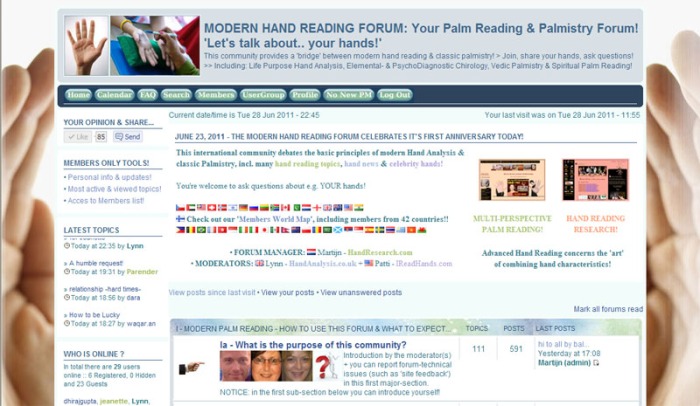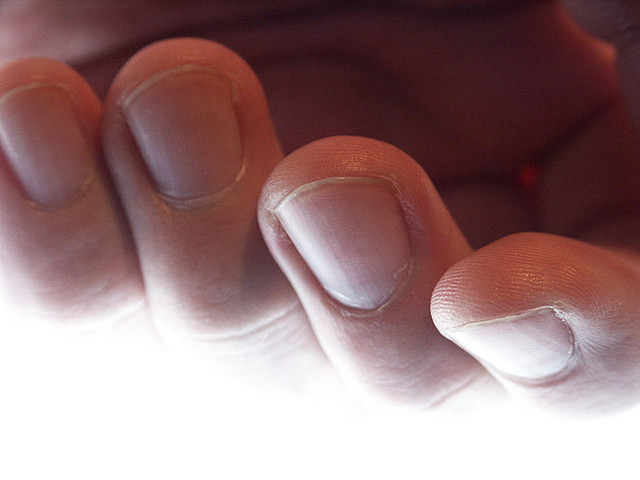Archive for June 2011
The Truth about White Spots on the Fingernail: Trauma, Stress or Zinc deficiency!
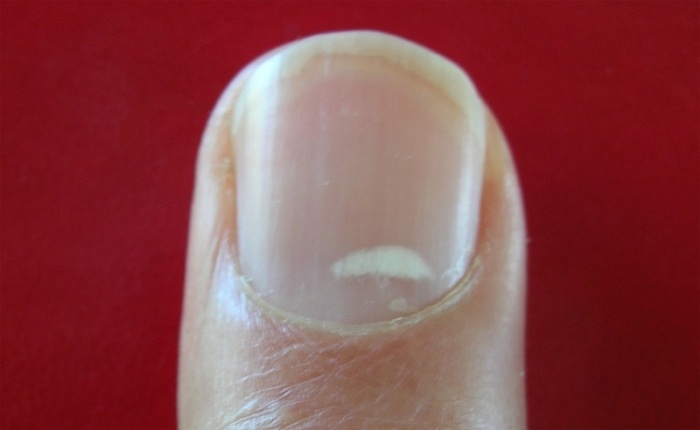
White spots on the fingernail are probably the most common ‘abnormality’ that can be observed in the nails. Many people associate them with calcium- or zinc deficiency. However, the truth is that usually they do not relate to any health problem at all: white spots are usually caused by a minor trauma!
In medical science white spots in fingernails are also known as ‘leukonychia punctata’ – which related to the presence of nucleated keratinocytes.
NOTICE: Narrow white lines in the nails are known as ‘transverse leukonychia’.
Usually white spots are caused by random minor trauma (including: such as pushing nail cuticles, or ‘nervous’ cuticle picking), and therefore it is not surprizing at all that white spots are relatively common in the hands of children!
White spots & zinc deficiency?
 Despite that white spots typically are the result of a minor physical trauma, studies have shown that sometimes white spots can be the result of a zinc deficiency – so that part of the ‘folklore’ has a ground! (See for example: Fingernail white spots: possible zinc deficiency)
Despite that white spots typically are the result of a minor physical trauma, studies have shown that sometimes white spots can be the result of a zinc deficiency – so that part of the ‘folklore’ has a ground! (See for example: Fingernail white spots: possible zinc deficiency)
Interestingly, in this perspective there even appears to be a connection between zinc definciency & trauma: stress! And in the field of palm reading professional palm readers have observed that white spots typically manifest in the fingernails when people experience a higher amount of stress than they usually do.
But in general, one should not expect to find a zinc deficiency when a person has only a few white spots. Because actually, a number of conditions can arise from a lack of zinc. One of the most important, which also lead to its discovery, was the stunting of growth and the lack of sexual development in adolescent boys; adding zinc to the diet brought about a rapid improvement. Skin complaints such as dermatitis and a condition called acrodermatitis in babies may result from deficiency, and there may be slow healing of burns and wounds. So zinc deficiency may show up as white spots or bands on fingernails, but probably only when other conditions manifest as well!
More details are discussed in the following topic at the Modern Hand Reading Forum:
http://www.modernhandreadingforum.com/t201p15-white-spots-on-nails-leukonychia
White spots & calcium deficiency?
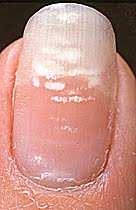 This part of the ‘folklore’ is not true. The Asia Pacific Journal of Clinical Nutrition reports:
This part of the ‘folklore’ is not true. The Asia Pacific Journal of Clinical Nutrition reports:
“There is no evidence to support a relationship between the white flecks and calcium or any other nutritional deficiency. Of course it is possible that people who have white flecks in their fingernails may coincidentally be deficient in calcium. White spots in fingernails may result from minor damage caused by bumping the nails into hard surfaces like bench tops or machinery. These white flecks are different from the white bands that are observed in nails of some undernourished children in developing countries, and in people who have low blood protein levels for various reasons.”
Conclusion: white spots do NOT indicate a calcium deficiency!
SUGGESTION FOR FURTHER READING:
• What are the most common nail disorders?
• Fingernail disorders & medical hand analysis!
The Modern Hand Reading Forum celebrates it’s 1st Anniversary!
|
The Sydney Line & the Simian Crease are like ‘Fraternal Twins’!

Normal palm creases - simian crease - Sydney line.
Many people are fimiliar with the concept of a simian crease, but there is a likewise fascinating line that has a likewise significance: the Sydney line. In modern medical science both the simian crease & the Sydney line became known as a ‘minor physical anomaly’!
In a 1967 Belgian study Vrydagh-Laoureux pointed out that next to the well-known simian crease (or ‘simian line’ – which became well-known for it’s significance in Down syndrome), there is actually another hand line variant that is associated with related to Down’s syndrome. In the Belgian study this line was described as an ‘extended proximal palmar crease’.
NOTICE: In the traditional palmistry vocabulary this line is often described as: an ‘extended’ or very long head line.
Interestingly, only one year later Australian researchers (Purvis-Smith & Menser, 1968) found that this fascinating palmar line is also frequently found in the hands of patients with congenital rubella – and from that point this ‘fraternal twins line’ of the simian crease has been named: the Sydney line (or sometimes named: ‘Sydney crease’). This twin-analogy could become valuable because many people often find it difficult to discriminate a simian line from a Sydney line!

Example of the Sydney line presented by Purvis-Smith (1972).
Purvis-Smith defined the Sydney line as follows:
“A sydney line occurs where the proximal transverse crease extends beyond the midline axis of the fifth finger towards the ulnar border of the palm the ulnar border of the palm.” (Purvis-Smith, 1972)
MINOR PHYSICAL ANOMALIES:
At the end of 20 century a new trend became appearant within the medical scientific community. Researchers began study so-called ‘minor physical anomalies‘ – which concern typically harmless inborn physical markers (that are typically associated with a specific prenatal period) – that have been associated in various disorders.
And especially in the 21 century this approach became popular among researchers who are studying the etiology of e.g. autism, ADHD, Down syndrome, hypoxia & schizophrenia.
MULTI-PERSPECTIVE PALM READING:
Multi-Perspective Palm Reading demonstrates how the Sydney line & simian crease can be understood as a likewise hand line markers. Because (so far) a wide range of studies indicates that in far most diseases & syndromes where the simian crease has been recognized as a significant body marker… the Sydney line became recognized as a likewise significant body marker.
This pattern is seen e.g. in: diabetes mellitus, Down syndrome, fragile-X syndrome, rheumatoid arthritis, and schizophrenia!
Finally, discussion in the Modern Hand Reading Forum have shown that – despite the fact that a Sydney line and a simian line can never be observed in one hand – for many people it quite hard to discriminate a Sydney line from a simian crease. The picture below presents a few fundamental clues which could become helpful to understand the essential components of both lines.
NOTICE: A ‘common hand’ is featured with a life line [I], a head line [II], and a heart line [III]; and various hand line variations can be summarized with the following formulas [IIx = extended head line; II+III = simian crease]:
• COMMON HAND = I + II + III
• SYDNEY LINE = I + IIx + III
• SIMIAN LINE = I + II-III
Obviously, there is a fundamental difference between the Sydney line and simian crease – therefore it appears more appropriate to describe them as ’fraternal twin lines’ instead of ‘identical twin lines’; because while they have a common nature… their manifestion shape is definitiely not identical.
More details are discussed in the following discussion:
http://www.modernhandreadingforum.com/t861p120-how-to-discriminate-a-simian-crease-from-a-sydney-line-and-a-suwon-crease

Dr. Erina Lee Describes How to Use Hands in Building Relationships!
 As a research scientist, Dr. Lee is responsible for the international relationships research at eHarmony. In the following article she described how the hands can become involved in building relationships.
As a research scientist, Dr. Lee is responsible for the international relationships research at eHarmony. In the following article she described how the hands can become involved in building relationships.
Whether they’re soft and manicured, strong and calloused, weathered and wrinkled—hands come in all shapes and sizes and can often say a lot about you. They can reveal the tattered fingernails of nervous nail biter, the orange fingers of a cheese puff lover, or the worn hands of a grandmother. And when you look even closer at the many lines and wrinkles, is it possible that your hands can reveal even more? Some people believe that clues to our basic selves can be found in the details of our hands. But do our hands really tell us anything of importance about who we really are? Is it possible that the numerous bumps and ridges unique to every hand hold some insight into our level of intelligence or into our love lives?
In an eternal quest for self-discovery, people have looked towards palm readers, among other mystics, to see if the lines in their hands really tell them something meaningful about themselves and their future. In current times, people turn to internet quizzes and online palm reading to make sense of the heart and life lines and the shape of their hands. Although these tests and quizzes can be fun, when put to the test of empirical science, most of these claims and predictions cannot be verified. Furthermore, these uncorroborated predictions about personality traits and future events leave palmistry in the category of a pseudoscience.
 Despite the inaccuracy of palm readings, however, there are aspects of the hands that have been studied empirically, including finger length. When looking at the palm of your hand, fingers straight together, you will likely notice a difference between your second (index) and fourth (ring) fingers. On average women have longer index fingers, compared to ring fingers while men have longer ring fingers compared to index fingers. This association between the two fingers, called the 2D:4D ratio, is related to levels of androgen exposure (a sex hormone higher in men) in the womb. That means that the amount of male hormones a fetus is exposed to determines this very specific detail of finger length in the hands. The precise mechanism by which androgen works is not entirely clear, but in general most theorists believe that increasing androgen exposure will masculinize a fetus. There is also some evidence suggesting that either too much or too little androgen can be feminizing to the fetus.
Despite the inaccuracy of palm readings, however, there are aspects of the hands that have been studied empirically, including finger length. When looking at the palm of your hand, fingers straight together, you will likely notice a difference between your second (index) and fourth (ring) fingers. On average women have longer index fingers, compared to ring fingers while men have longer ring fingers compared to index fingers. This association between the two fingers, called the 2D:4D ratio, is related to levels of androgen exposure (a sex hormone higher in men) in the womb. That means that the amount of male hormones a fetus is exposed to determines this very specific detail of finger length in the hands. The precise mechanism by which androgen works is not entirely clear, but in general most theorists believe that increasing androgen exposure will masculinize a fetus. There is also some evidence suggesting that either too much or too little androgen can be feminizing to the fetus.
Because androgen exposure is related to sexual development and masculinization, researchers have begun to wonder if the 2D:4D ratio, as a marker of hormone exposure, may also predict other characteristics. Hormone exposure has been linked to things like general physical health, cognitive abilities, personality, job preferences, attractiveness, and sexual orientation. While the 2D:4D ratio may relate to these developmental characteristics, thus far the evidence supporting such a link is at best described as mixed. For example, there has been much attention dedicated to whether the 2D:4D ratio relates to sexual orientation. While there have been several studies in this area, some have shown no differences between heterosexual and homosexual men in their 2D:4D ratios (e.g., Williams et al., 2000), and others, like Lippa, have shown heterosexual men having lower 2D:4D ratios compared to homosexual men. Similarly with other characteristics like personality and attraction, the research findings have been fairly inconsistent.
 Another aspect of the hands that have been conclusively studied are the ridges, the ones that cover the palms and fingers, the ones that make up our unique fingerprints. The study of these ridges is called dermatoglyphics. Similar to the finger length, these ridges are known to be established earlier in the embryonic development, while the fetus is still in the womb. Researchers have shown dermatoglyphic differences between non-deficient people and those with cognitive or genetic abnormalities, like schizophrenia, Down’s syndrome, and intellectual disability. For example, individuals diagnosed with schizophrenia show fewer ridges between two specific points under the second and third fingers [a-b ridge count] compared to non-schizophrenic controls (Bramon et al., 2005). These findings support the idea that changes in the prenatal environment can display its effects in multiple ways, including changes in cognitive development and ridges of the hands. However, the findings do not assume that all people with fewer ridges have cognitive deficiencies.
Another aspect of the hands that have been conclusively studied are the ridges, the ones that cover the palms and fingers, the ones that make up our unique fingerprints. The study of these ridges is called dermatoglyphics. Similar to the finger length, these ridges are known to be established earlier in the embryonic development, while the fetus is still in the womb. Researchers have shown dermatoglyphic differences between non-deficient people and those with cognitive or genetic abnormalities, like schizophrenia, Down’s syndrome, and intellectual disability. For example, individuals diagnosed with schizophrenia show fewer ridges between two specific points under the second and third fingers [a-b ridge count] compared to non-schizophrenic controls (Bramon et al., 2005). These findings support the idea that changes in the prenatal environment can display its effects in multiple ways, including changes in cognitive development and ridges of the hands. However, the findings do not assume that all people with fewer ridges have cognitive deficiencies.
To summarize, we do know that specific details in our hands are affected by early hormonal exposure and other environmental influences in the womb. And we know that this early exposure also affects other aspects of our development. While it is intriguing to speculate further that details in our hands can predict aspects of our personality or behavior, these conjectures have not been empirically supported. It’s also likely that there are more direct measures of personality, intelligence, and behavioral traits rather than the hands. But even though you can’t currently rely on your hands to unlock all of your mysteries, one thing you can count on is more studies and discussion about them to come.
What can a single Fingerprint really reveal?
Fingerprints mark us out as individuals and leave telltale signs of our presence on every object that we touch. However, what else can a fingerprints reveal? Authors of many palm reading books suggest that a single fingerprint represents certain ‘fixed’ qualities. However, there has never been presented any evidence which support such specific claim. And despite the fact that certain fingerprint characteristics correlate highly for sexe an individual, even the sexe can not always be determined from a single fingerprint!
What can a single fingerprint reveal? As a matter of fact, there are many myths about fingerprints. For quite a while scientists assumed that the purpose of fingerprints should be associated with giving ‘grip’ to the hand. But even this ‘grip’ theory became doubtful according a 2009 study.
CAN A SINGLE FINGERPRINT REVEAL IF IT BELONGS TO A MALE OR FEMALE?
The current state of knowledge is that only the distal region of a fingerprint correlates with sexe. Studies have revealed that fingerprint ridge densities of 12 or less (per 25 mm) is usually a male, while fingerprint ridge densities of 15 or more (per 25 mm) is usually a female. But fingerprint ridge density alone can not reliably predict the sexe in large samples (below 75%).
However, there is a long list of tiny fingerprint characteristics that are also significant for sexe; and combining ridge density with those characteristics will usually result in a correct identification of sexe – especially when applied to the pinky finger.
A summary of major & minutiae ridge characteristics that vary among males & females:
1 – Finger size: larger in males;
2 – Ridge dots: more common in males (34%) than in females (20%);
3 – Short ridges: more common in males (38%) than in females (23%);
4 – Ridge spurs: more common in males (32%) than in females (26%);
5 – No ridge endings: more common in females (8% ) than in males (2%);
6 – Ridge lakes: more common in females (45%) than in males (35%);
7 – Ridge thickness to valley thickness ratio (RTVTR): lower in females;
8 – Ridge count: lower in females.
READ MORE ABOUT FINGERPRINTS:
• Fingerprint distributions & hand diagnostics
• Fascinating articles & reports about fingerprints
Fingerprints reveal Clues about Sexe, Race, Diet, Lifestyle & Disease!
The papillary ridges in every fingerprint are unique to each individual, and these characteristics do not change over time (after fixation during the 2nd and 3th prenatal month). Therefore fingerprints became recognized as a usefull tool for identification. However, the certain details in a fingerprint + the distribution of the pattern types among the 10 fingers can reveal much more!
In general, one could say that beyond identity fingerprints can reveal clues that relate to: sexe, race, diet, lifestyle, and disease. Below follows an introduction to how fingerprints are related to these themes.
FINGERPRINTS & SEXE:
Biometric studies have shown that fingerprint type distributions & palmar dermatoglyphics vary significantly among both sexes: females have more arches, and males have more whorls. However, another stricking sexe-difference is that females usually have more ridges per cm2.
FINGERPRINTS & RACE:
Anthropologic studies have revealed that fingerprint type distributions vary significantly among the populations around the world. More details have been reported in the posts about the Fingerprint World Map & the World Populations.
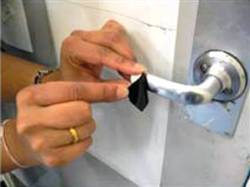 FINGERPRINTS & DIET:
FINGERPRINTS & DIET:
A few years ago reports have been made that using commercial gelatine based tape (which was already used by police) and high-tech chemical analysis under spectroscopic microscope – provides a detailed picture of the chemical- & metabolic make-up found on a fingerprint. The study revealed that specific amino acids indicated whether the “suspect” was a vegetarian or meat-eater, and different fatty acid profiles suggested provided clues to their racial origins.
FINGERPRINTS & LIFESTYLE:
The same microscope method (based on the study of chemicals & metabolics featured with a fingerprint) can also unveal e.g. the use of substances, including: cigarettes, drugs & grooming products. And even age can be determined roughly with this method!
FINGERPRINTS & DISEASE:
Scientists have stated that the scientific study of dermatoglyphics in an individual (via: the palmar dermatoglyphics & the fingerprints) can tell doctors about the risk for certain diseases. Multi-Perspective Palm Reading describes the link between fingerprints & diseases by detail!
The Purpose of Palm Reading: ‘why study the Hand?’
Long before the hands was discovered as a diagnostic tool, many great philosophers have described the significance of the hand perceived from various perspectives.
The following quotes represent a few early examples describing the philosophical importance of hands:

Aristotle (384BC - 322BC)
“… (the hand) is the organ of the organs, the active agent of the passive powers”

Sir Charles Bell (1774-1842).
“The hand is essentially the organ of the mind, the medium of its expression, and the Instrument whereby its promptings are carried into execution”

Carl Gustav Jung (1875-1961).
Carl Gust Jung, the Swiss psychiatrist said:
“Chirology [hand reading] is an art which dates back to very ancient times. The ancient physician never hesitated to make use of such
auxiliary systems as chiromancy and astrology for diagnostic and prognostic purposes as is shown, for instance, by the book of Dr. Goclenius who lived at the end of the sixteenth century. … The totality-conception of modern biology which is based on the evidence of a host of observations and research does not exclude the possibility that hands, whose shape and functioning are so intimately connected with the psyche, might provide revealing and therefore, interpretable expressions of psychical peculiarity, that is, of the human character. …”
World Population Study shows: Fingerprint in Pointer Finger is most unique!
Every person has unique fingerprint. In the forensic sciences the process of comparing two fingerprints – known as ‘dactyloscopy‘ – is focussed on identifying tiny characteristics in the friction ridge skin. However, fingerprint pattern types are not unique at all: they e.g. fingerprint pattern types highly depend on sexe & race. An international study points out that the fingerprint type in the pointer finger is most unique!
In order to study the interactive effects of sexe & race in fingerprints (dermatoglyphics), a study has been conducted on fingerprint samples in 5 world populations (2.785 people) – including: Americans (A), British (B), Chinese (C), Iranians (I), and Nigerians (N).
Only the so-called Vucetich fingerprint types were considered in this study, which is founded on the number of triradii + their location:
– whorls are characterised by the presence of 2 triradii;
– ulnar loops are characterised by the presence of 1 triradius positioned at the thumb-side;
– radial loops are characterised by the presence of 1 triradius positioned at the pinky-side;
– arches are characterised by the absense of a triradius.
The results of the study are shown in the picture below:

_
FINGERPRINTS & SEXE:
International studies in the past have shown that fingerprint types in females almost universally differ from males in having more arches. And usually females also differ in bearing fewer whorls, and typically they also tend to have slightly less radial loops.
The new study shows that in all 5 populations arches are much more common in females: +44.9% (compared to males); and whorls are indeed less common in females: – 10.5% (compared to males). And as expected the sexe-effects in radial loops (-0.6%) and ulnar loops is much smaller (+2.3%).
Interestingly, the most typical sexe-effect for arches is by far less prominent in the index finger: +11.5% (compared to the other fingers: thumb: +57.6%, middle finger: +69.4%, ring finger: +58.4%, pinky finger: +123.1%). This indicates that the fingerprint type in the index finger is least ruled by sexe.
FINGERPRINTS & RACE:
The Fingerprints World Map has shown that studies in the past have shown that the occurence of fingerprint types varies significantly in the populations around the world: e.g. Asians are known for a higher occurence of whorls, and Africans for a higher occurence of arches.
The new study confirms these earlier findings:
– Whorls are by far most common in Chinese males (48.2%) and females (45.4%);
– Arches are by far most common in Nigerian females (13.7%) and males (9.1%).
Interestingly again, the details show that the most typical racial-effects are least prominent in the index finger – in the picture this is e.g. also indicated by the relatively small variance for the ulnar loops among the races!
POINTER FINGER HAS THE HIGHEST VARIABILITY:
Summarizing, the study has shown that sexe & race have relatively small effects on the fingerprint type of the pointer finger.
And this might actually makes sense, because the pointer finger [index finger] is known for displaying the highest level of variability – e.g. arches & radial loops are known for manifesting by far most often on the index finger (and the same is true for less common fingerprint types such as: the tented arches & accidentals).
FINGERTIP BIOMETRY – Fingertips Signal Clues for Schizophrenia!
Many studies have revealed that syndromes & diseases become manifest in hand functions & many aspects in the morphology of the hands. Interestingly, a closer look a the studies performed so far indicates that for the hand in schizophrenia the significance of the fingertips is more important than in other disorders!
A person diagnosed with schizophrenia may experience hallucinations (most reported are hearing voices), delusions (often bizarre or persecutory in nature), and disorganized thinking and speech. But there are no symptoms which are seen in all schizophrenic patients.
 In order to understand the connection between hands and schizophrenia thorougly, it is important to be aware of the essential difference between the so-called ‘positive symptoms‘ and ‘negative symptoms‘. Because some of the fingertip characteristics in schizophrenia are associated with only category of the symptoms! (More details will be revealed later)
In order to understand the connection between hands and schizophrenia thorougly, it is important to be aware of the essential difference between the so-called ‘positive symptoms‘ and ‘negative symptoms‘. Because some of the fingertip characteristics in schizophrenia are associated with only category of the symptoms! (More details will be revealed later)
NOTICE: The ‘positive symptoms’ in schizoprenia are those symptoms that most individuals do not normally experience but are present in people with schizophrenia (such as: hallucinations & disordered speech). And the ‘negative symptoms‘ are deficits of normal emotional responses or of other thought processes, and respond less well to medication (such as: blunted affect & poverty of speech).
FIVE FINGERTIP DIMENSIONS IN SCHIZOPHRENIA!
A closer study of the reports published so far, unveals that in schizophrenia at least 5 dimensions of the fingertips provide significant clues, including:
FINGERTIP DIMENSION 1 – Fingerprints:
– 1a: extralimital triradii (prevalence: 6.6% in schizophrenics vs. 1.5% in controls);
– 1b: fingerprint type asymmetry on 3 or more fingers.
FINGERTIP DIMENSION 2 – Fingernails:
– small & underdeveloped (prevalence: 18.8% in schizophrenics vs. 2.0% in controls).
FINGERTIP DIMENSION 3 – Shape:
– 3a: short length is typical (prevalence: unknown);
– 3b: spatulate is typical (prevalence: 42.4% in schizophrenics vs 21.7% in controls).
FINGERTIP DIMENSION 4 – Skin:
– blood vessels in proximal nail fold are visible (prevalence: 20-70% in schizophrenics vs. 3-7% in controls);
FINGERTIP DIMENSION 5 – Creases:
– excessive (prevalence: unknown);
(The sources for the percentages are listed in the article: How to make a Palm Reading Assessment
for SCHIZOPHRENIA?)
 FINGERTIPS & THE BRAIN:
FINGERTIPS & THE BRAIN:
Interestingly, there appears to be a connection as well regarding how schizophrenia is linked with the brain! Because after Penfield described in his cortical homunculus (see the picture on the right) in the 1940’s how the primary somatosensory cortex is linked with e.g. the fingertips, brain studies have later revealed that schizophrenia is often featured with abnormalities in the same region of the brain (+ other near located parts of the brain, including: the thalamus & frontal lobe).
FINGERTIP DIMENSIONS IN OTHER DISORDERS?:
The following summary shows that only three out of the five fingertip dimensions that provide significant clues for schizophrenia, also display significant clues in 6 other diseases & syndromes that are well known for displaying significant hand markers. Only rheumatoid arthritis provides clues in these three fingertip dimensions!
FINGERTIP DIMENSION 1 – Fingerprints:
Significant for the hand in Down syndrome, the hand in diabetes mellitus, the hand in fragile-X syndrome, and the hand in rheumatoid arthritis.
FINGERTIP DIMENSION 2 – Fingernails:
Significiant for the hand in Down syndrome, the hand in diabetes mellitus, the hand in Marfan syndrome, the hand in psoriasis, and the hand in rheumatoid arthritis.
FINGERTIP DIMENSION 3 – Shape:
Significant for the hand in Marfan syndrome, the hand in psoriasis, and the hand in rheumatoid arthritis.
FINGERTIP DIMENSION 4 – Skin:
No significant markers for any of the six studied diseases & syndromes.
FINGERTIP DIMENSION 5 – Creases:
No significant markers for any of the six studied diseases & syndromes.
These materials indicate that a significant part of the correlations between the hands & schizophrenia is found at the fingertips. To be continued!

Penrose's brain homunculus describes how the fingertips relate to the primary somatosensory cortex & the primary somatomotoric cortex.
Nailfold Blood Vessels reveal a Biological Marker for Schizophrenia!

Visibility of the nailfold blood vessels plexus has been known for a long time as a biological marker in schizophrenia.
In an earlier post is described that schizophrenia became known for a high occurence of minor physical anomalies (MPA’s). Another example of a developmental abnormality that has been studied as a hand marker for schizophrenia, but which lies outside the scope of the traditional MPA construct, is the occurence of visibility of the blood vessels in the proximal nailfold – a.k.a. ‘nailfold plexus visibility’ (NPV – which requires the use of a microscope for proper assessment). A high level of nailfold plexus visibility is rare in the general population (occurring in 3-7% of healthy adults) while the rate of high NPV ranges from 20-70% in populations with schizophrenia (Curtis et al., 1999).
Interestingly, over the years studies have suggested this hand characteristic is specificly related to the so-called ‘negative symptoms’ in schizophrenia (which are associated with deficits of normal emotional responses or of other thought processes). And EEG studies have revealed that this nail fold blood vessel condition may mark a process associated with abnormal brain development leading to schizophrenia – including: an inverse relationship between plexus visibility and lateral ventricle size in the brain. The PVS is reliably determined and stable over time. Interrater reliabilities for PVS reportedly range from .83 to .99 (Buchanan and Jones 1969; Maricq 1966).
Taken together, researchers have concluded that findings on MPAs indicate that these minor anomalies appear to be part of some schizophrenia syndromes, representing a stable systemic or physical set of manifestations of the underlying neurodevelopmental processes that lead to the illness. This might explain why in the DSM-V the term ‘schizophrenia’ may be get replaced by the name ‘psychosis risk syndrome‘.
BLOOD SUPPLY IN THE SKIN:
 The skin has a profuse blood supply, which is important in temperature regulation. The subcutaneous arteries form a network in the subcutaneous tissue, and from this is derived a subpapillary plexus in the dermis. Capillary loops in the dermal papillae arise from the subpapillary plexus, and from these loops the avascular epidermis is bathed in tissue fluid. A subpapillary plexus of venules gives the skin its pink color: the vessels become dilated when the skin is heated, and thereby make it look red.
The skin has a profuse blood supply, which is important in temperature regulation. The subcutaneous arteries form a network in the subcutaneous tissue, and from this is derived a subpapillary plexus in the dermis. Capillary loops in the dermal papillae arise from the subpapillary plexus, and from these loops the avascular epidermis is bathed in tissue fluid. A subpapillary plexus of venules gives the skin its pink color: the vessels become dilated when the skin is heated, and thereby make it look red.
NAILFOLD PLEXUS VISIBILITY & PSYCHOPATHOLOGY:
Just like is seen in the perspective of minor physical anomalies, nailfold plexia visibility is much more common in schizophrenia than in any other form of psychopathology. Studies have revealed that nailfold plexia visibility in schizophrenia is (much) more common than in other psychotic- & mood disorders – but these other disorders also show higher occurence than seen in the general population.
Studies have also shown that that patients with schizophrenia with a highly visible plexus have greater oculomotor dysfunction, negative symptoms, symptom severity, chronic course, and neuropsychological dysfunction. Furthermore, nailfold plexus visibility appears to be at least moderately heritable.
NAILFOLD PLEXUS & OTHER DISORDERS:
Other studies have revealed that nail fold plexus visibility has also been linked with hand markers in rheumatoid arthritis & hand markers in psoriasis. The pronounced subpapillary plexus visibility, greater number of vessels and their elongation are indicative of rheumatoid arthritis, while shorter, fewer capillaries and especially characteristic psoriatic capillaries, when present, suggest psoriatic arthritis.
Changes of nailfold capillary patterns have been described in certain patients with systemic sclerosis, dermatomyositis, mixed connective tissue disease, and Raynaud’s syndrome.
NOTICE: The nail tutor demonstrates how other nail fold characteristics can be associated with specific medical problems. More details about how to recognize various stages/variants of proximal nailfold blood vessels visibility in a palm reading, are presented in the picture below.
A phantom picture for the hand in schizophrenia is available here:
http://www.multiperspectivepalmreading.com/hands-schizophrenia-palm-reading.htm
Nailfold plexus changes are characterized by loss of (drop-out) nailfold capillary loops that surround the remaining, enlarged dilated capillaries. Upper left, A normal nailfold capillary pattern shows the uniform morphology and homogeneous disitribution of the small capillary loops just below the cuticle. Upper right, Capillaroscopy in a patient with systemic sclerosis illustrates dilatation of isolated capillary loops, with loss of surrounding loop structures. Lower right, The abnormal pattern is from a patient with childhood dermatomyositis. Dilated capillary loops are present, as well as areas of arborized clusters of capillary loops. Lower left, Distortion of the normal capillary loop architecture is seen in a patient with adult dermatomyositis. Note the loss of normal homogeneous distribution of the capillaries and the alterations in the morphology of the vessels, including the dilated and enlarged “giant” capillary loops.
